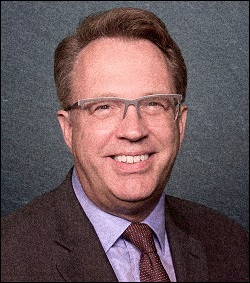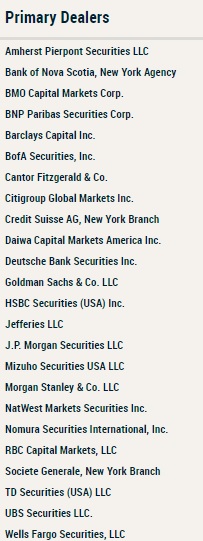By Pam Martens and Russ Martens: January 2, 2020 ~
Consumers represent two-thirds of GDP in the United States. And yet, when consumers run into trouble, they don’t get a handout from the Federal Reserve – they are forced to file bankruptcy. There are no Fed handouts to small business owners, farmers, or main street merchants either.
So why is it exactly that the trading houses on Wall Street, with a serial history of crimes and with the most overpaid and under-punished executives on the planet, are able to perpetually have secret communications with the New York Fed and magically turn on the flow of trillions of dollars of ridiculously cheap loans to bail out their hubris and corruption.
The obscene money spigot from the New York Fed to Wall Street’s trading houses didn’t start with the epic financial crisis of 2008, as most Americans believe. It started following the dot.com bust, which was fueled by fraudulent research from Wall Street’s trading houses. The money from the Fed to Wall Street simply flowed under the cover of the 9/11 crisis.
The emotional toll of 9/11 has caused a memory lapse among most Americans to the reality that the stock market and Wall Street were in freefall before 9/11 occurred. The Nasdaq stock market had closed at 1695 on the day before September 11, 2001 – a stunning 66 percent drop from its peak in March of 2000. The dot.com bust had led to one of the largest destructions of U.S. wealth in stock market history. The New York Times’ Ron Chernow wrote about the dire conditions on Wall Street six months before 9/11, penning this: “Let us be clear about the magnitude of the Nasdaq collapse. The tumble has been so steep and so bloody — close to $4 trillion in market value erased in one year — that it amounts to nearly four times the carnage recorded in the October 1987 crash.”
The Federal Reserve not only bailed out Wall Street after 9/11 but it carefully coordinated its public remarks about that bailout. At a teleconference call on the morning of September 17, Fed Chairman Alan Greenspan effectively warned the Fed governors to keep a lid on how much they shared with the public. According to the transcript of the call, Greenspan stated:
GREENSPAN: “For the time being, all of our remarks should be coordinated and made as official statements of the Federal Open Market Committee. As a consequence, when you are out talking — as indeed I think you obviously have to be — there is no reason why you cannot discuss what we have in fact done in areas such as the payments system and the swap lines. We can discuss issues relating to the effects of this disruption, including the bulging of the Federal Reserve’s balance sheet and the ultimate expectation that within a reasonably short period of time it will converge back to normal, as well as other issues of that nature. I would stay away from commenting on what we did just now and I would refrain from speculating about the American economy. There is no way to discuss the outlook for the American economy without discussing monetary policy or implying in somewhat precise form what the options may be…If there are any statements coming out of the Federal Reserve, we have to make certain that they are coordinated and that we all effectively agree on the statements that we make.”
The Fed’s money spigot to Wall Street after 9/11 took multiple forms: banks were allowed to overdraft their reserve accounts at the Fed to the tune of tens of billions of dollars and fees for these overdrafts were waived. According to a report from the New York Fed, an “unprecedented” amount of liquidity was pumped into the system. The Congressional Research Service quantified the “unprecedented” amount as “$100 billion per day” over a three-day period beginning on 9/11. But the bailout did not last just a few days or weeks. The consolidated annual reports of the Federal Reserve Banks show that the Fed’s balance sheet grew from $609.9 billion at the end of 2000 to $654.9 billion at the end of 2001 to $730.9 billion at the end of 2002 and $771.5 billion as of December 31, 2003.
Those vast dollar amounts suggest that the Fed bailout was really about shoring up the liquidity of the Wall Street banks after they brought on the Nasdaq crash as a result of the banks’ corrupt practices of pumping and dumping stocks they called “dogs” and “crap” in internal messages while they peddled them to unwary investors as great new start-up companies.
Then there was the Fed’s secret $29 trillion bailout from 2007 to 2010 following another period of epic corruption on Wall Street, this time involving bundled packages of subprime debt which the Wall Street banks knew from internal reports was doomed to fail. Wall Street banks brought down the entire U.S. economy and housing market while using the largesse from the Fed to reward their top executives with big bonuses and golden parachutes.
The Fed did more than just attempt to control the narrative of its massive bailout to the Wall Street banks. It fought a court battle for multiple years, refusing to name the recipient banks and the dollar amounts of its bailouts to them. Thanks to an amendment by Senator Bernie Sanders on the Dodd-Frank financial reform legislation of 2010, the Government Accountability Office (GAO) was forced to produce an audit of the Fed’s so-called “emergency loans” from December 2007 to July 21, 2010. The GAO tallied up $16.1 trillion in revolving loans, a significant part of which was made against dodgy collateral like junk bonds and stocks at a time when both markets were tanking – violating the age-old mandate that the Fed must make loans against good collateral like U.S. Treasury securities.
The Fed also violated its mandate of making loans to only solvent institutions. For a good portion of the time the Fed was making loans at less than one percent interest to Citigroup, it was clearly an insolvent institution that couldn’t have obtained loans in the private market at even double-digit interest rates.
The GAO’s audit acknowledged that it did not cover all of the Fed’s secret loans to Wall Street. After losing its court appeal, the Fed was forced to turn over its data to the media. That resulted in the Levy Economics Institute finishing the GAO’s work, with a tally of $29 trillion in cumulative bailout funds from the Fed to save the Wall Street banks and their derivative counterparties. The bulk of that was funneled out by the New York Fed.
Beginning on September 17 of this year, when Wall Street became unnerved that overnight loan rates spiked to 10 percent from an average of 2 percent, the New York Fed once again turned on its money spigot to Wall Street’s trading houses. On every business day since September 17, the New York Fed has been gushing out tens of billions of dollars to Wall Street. And, once again, it will not tell the public which trading houses are getting this money, how much each is getting, or why these banks need this money.
The cumulative total of these Fed loans since September 17 is now in the trillions of dollars. As of this morning, the New York Fed was pumping out this money at a ridiculously low rate of interest of 1.55 percent. Without the Fed’s artificial loan market, these loans would cost 10 percent or more.
All that we are allowed to know from the Fed about where this money is going is that its 24 “primary dealers” are allowed to borrow under this program. (See list below.) For the most part, those are the same trading units of the same Wall Street banks that got obscene loans after 9/11 and during the epic crash of 2007 to 2010.
The credit card divisions of many of these same banks are charging struggling American consumers an average of 17 percent on their credit cards while another part of the bank is borrowing at 1.55 percent from the Fed.
As Senator Bernie Sanders said after the GAO released its audit of the Fed, this is “socialism for the rich, and rugged, you’re-on-your-own individualism for everyone else.”
The Fed’s actions represent an outrage of epic proportions and yet you will not find one mainstream newspaper in America that believes what the Fed is doing is worthy of a front-page headline.



